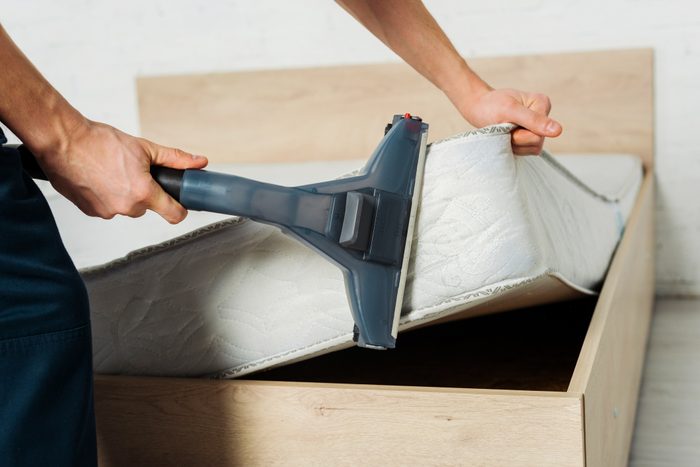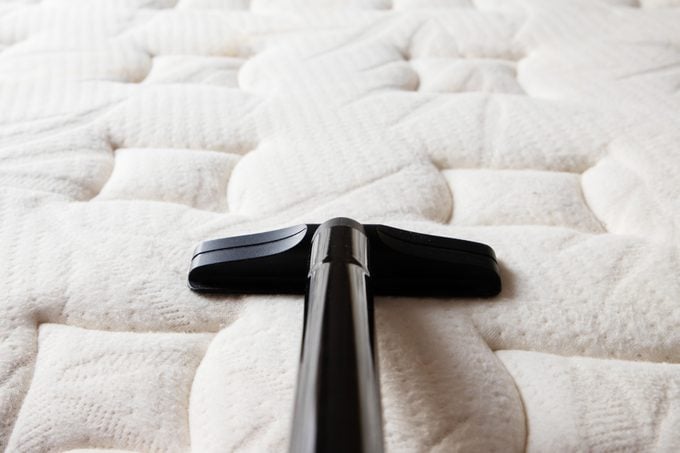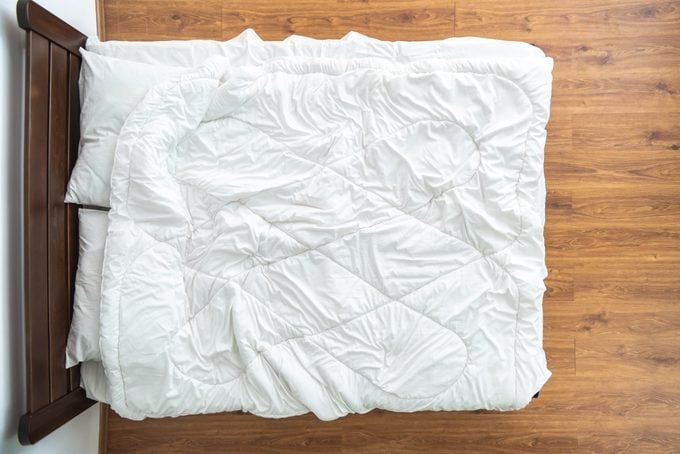How to Clean—and Deep Clean—a Mattress
Updated: Apr. 13, 2023

The experts weigh in on how to clean your mattress—and how often you should.
When it comes to buying a mattress, most of us spend a ton of time researching the best one. Whether it’s a bed in a box or from a store, we want to make sure that our mattress is non-toxic, comfy, and affordable. But once you’ve gone ahead and invested in the mattress of your dreams, have you ever given any thought to how dirty it might get? Even if you change your bedding regularly and don’t allow any pets or shoes on your bed, you may be surprised to find that your mattress isn’t as clean as you think. That’s because over time, things like dead skin cells, dust mites, dirt, bodily fluids, and a host of other things that make you say “ick” can accumulate on your mattress. In fact, Amerisleep reports that after seven years, mattresses can house more than 16 million colony-forming units (CFUs) of bacteria. Yuck!
So, what should you do? “Cleaning is how you care for your mattress,” says Mary Gagliardi, aka “Dr. Laundry,” the in-house scientist and cleaning expert for Clorox. “Cleaning your mattress eliminates things like dust and pet dander, and also helps it last longer.” Another way to extend the life of your mattress is by purchasing one of the best mattress toppers.
How often you should clean your mattress
First and foremost, it’s important to note that “clean” doesn’t always mean soap and water—especially when it comes to mattresses. In fact, Gagliardi stresses that “it’s important to avoid getting a mattress too wet.” Otherwise, the interior will become a breeding ground for mold and mildew. That’s why Gagliardi recommends vacuuming your mattress. “At a minimum, vacuum every three to four months when you rotate and flip a mattress (also an important part of mattress care),” she says. “If you have a mattress that doesn’t require flipping, you should still rotate it every three to four months, so be sure to vacuum at the same time.”
What to use to clean a mattress
For routine cleaning, Gagliardi recommends a vacuum with a HEPA filter that doesn’t return everything you are vacuuming up back into the room. “Routine cleaning of a mattress really just involves vacuuming with the upholstery attachment on the vacuum to get into the crevices and quilted covering,” she says. One of these dependable vacuum cleaners should do the trick!
How to deep clean a mattress

It’s always a good idea to deep clean rugs and surfaces in your home. But should you deep clean a mattress? No, not if you mean scrubbing it with soap and water. According to Gagliardi, getting a mattress really wet is bad for it. In fact, getting a mattress too wet can ruin it altogether. Instead, she recommends routine cleaning with a good vacuum and spot cleaning stains.
How to get stains out of a mattress
The most common mattress stains are typically from bodily fluids like sweat, urine, and blood. And contrary to popular belief, you can get blood out of your bedding. For these stains, you’ll want a good mattress cleaner that doesn’t get your mattress too wet. Gagliardi recommends this hydrogen peroxide–based Clorox Urine Remover, since it works on protein-based stains like urine and blood, and is safe for use on mattresses. Spray this product onto the stains and then wait three minutes before blotting the treated area with a clean, damp cloth.
If you don’t have a store-bought mattress stain remover on hand, you can make your own quickly and easily using a combination of everyday items that you already have in your home. The Sleep Foundation recommends making a 1:1 solution of cold water and hydrogen peroxide. Apply that solution to the stain and blot using a clean cloth. Then, using another clean cloth, blot the stained area with fresh water. Repeat this process until the stain is removed. A mixture of half vinegar and half water is also an effective and more natural way to spot clean your mattress.
Whether you use a commercial mattress stain remover or make your own, the last step is the most important. That is to let your mattress air-dry completely. Gagliardi suggests running a fan to circulate air in the room. Once the mattress is completely dry, then you can put the bed linens back on. If your pillows need some cleaning too, here’s how to get yellow stains out of your pillows.
How to remove odors from a mattress
If your mattress is smelling a bit funky but has no obvious stains, there are a few ways to remove odors. Gagliardi recommends spraying the surface of your mattress until damp—not saturated—with Clorox Fabric Sanitizer Aerosol Spray. Again, allow the mattress to air-dry completely before putting your sheets back on.
Another surefire way to remove odors from a mattress is with good old baking soda. Sprinkle a thin layer of baking soda over the entire surface of your mattress, and allow it to sit for a few hours. The baking soda absorbs moisture and neutralizes odors. Once you’ve allowed the baking soda to sit for a few hours, vacuum it up using your vacuum’s upholstery attachment, and then put your bed linens back on.
When is it time to replace your mattress?

When it comes to common stains like blood or sweat and urine, the latter of which can be the cause of those pesky yellow stains, Gagliardi says they are all absolutely worth cleaning. But there are times when you should replace your mattress sooner than the typical seven years. According to Gagliardi, a mattress should be replaced if it gets too wet and cannot dry out properly. For example, if your house floods, it’s probably a good idea to cut your losses and replace your mattress.
In other instances, she points out that you’ll definitely want to replace a sagging mattress. How can you prevent sagging? She advises that you rotate and flip your mattress (if it can be flipped) on a regular basis, as directed by the manufacturer. She points out that most mattresses have a life span and that they should last that long when properly cared for. After that, you can evaluate your mattress’ condition and decide when to replace it.
Remember to wash your mattress pad cover, too
When it comes to caring for your mattress, Gagliardi also advises cleaning your mattress pad cover on a regular basis. “At a minimum, wash it when you vacuum and rotate the mattress using a good detergent and 1/3 cup bleach,” she says. “Mattress covers [should] be clean, white, and germ-free, too!” And speaking of mattress covers, she recommends looking for one that is “waterproof” as opposed to “water-resistant.” Water-resistant just means it resists water but can’t prevent it from getting through completely. In the event of an accident on a water-resistant mattress cover, you’re likely to end up with stains.
Sources:
- Mary Gagliardi, aka “Dr. Laundry,” Clorox’s in-house scientist and cleaning expert
- Amerisleep: “Bacteria in your Bed”
- Sleep Foundation: “How to Clean a Mattress”
